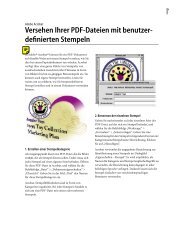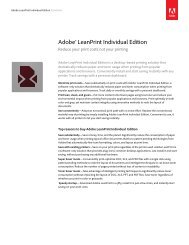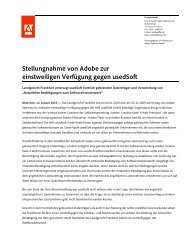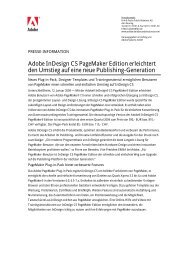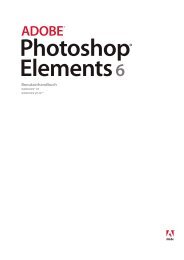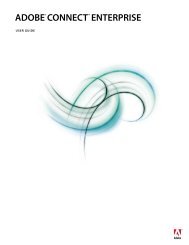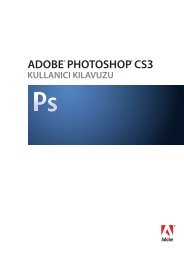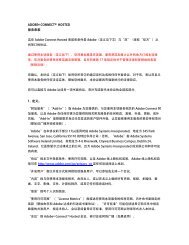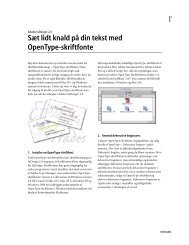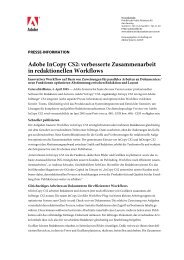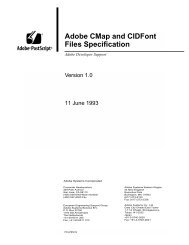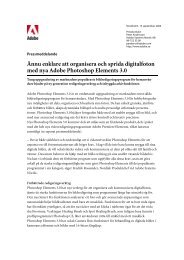Brioso Pro - Adobe
Brioso Pro - Adobe
Brioso Pro - Adobe
- TAGS
- brioso
- adobe
- www.adobe.com
You also want an ePaper? Increase the reach of your titles
YUMPU automatically turns print PDFs into web optimized ePapers that Google loves.
<strong>Brioso</strong> <strong>Pro</strong><br />
a®
a<br />
2<br />
�ab c d e
An <strong>Adobe</strong>® Original<br />
<strong>Brioso</strong> <strong>Pro</strong><br />
� �umanistic Composition �a�ily<br />
fg h i j klmnopq rst<br />
© 2003 <strong>Adobe</strong> Systems Incorporated. A�l rights reserved.
uv wxyz<br />
For more information about OpenType please refer to <strong>Adobe</strong>’s web site at www.adobe.com/type/opentype.<br />
�is pdf document was designed to be viewed on-screen or printed duplex and assem�led as a booklet.<br />
4
<strong>Adobe</strong> Originals<br />
<strong>Adobe</strong> Systems Incorporated introduces <strong>Brioso</strong> <strong>Pro</strong>, a new font<br />
so�ware package in the growing library of <strong>Adobe</strong> Originals typefaces,<br />
designed �eci�ca�ly for today’s digital technology. Since the inception<br />
of the <strong>Adobe</strong> Originals program in 1989, <strong>Adobe</strong> Originals typefaces<br />
have been consistently recognized for their quality, originality, and<br />
pra�icality. They combine the power of PostScript® lan�uage so�ware<br />
and the most sophisticated electronic design tools with the spirit<br />
of cra�smanship that has inspired type designers since Gutenberg.<br />
Comprising both new designs and revivals of classic typefaces, <strong>Adobe</strong><br />
Originals font so�ware has set a standard for typographic exce�lence.<br />
What is OpenType?<br />
Developed jointly by <strong>Adobe</strong> and Microso�, OpenType is a highly<br />
versatile new font �le format that represents a signi�cant advance<br />
in type functionality on Windows® and Mac OS computers. Perhaps<br />
most exciting for designers and typographers is that OpenType fonts<br />
offer extended layout features that bring unprecedented control and<br />
sophistication to contemporary typography.<br />
Because OpenType can incorporate a�l glyphs for a �eci�c style<br />
and weight into a single font, the need for separate expert, alternate,<br />
swash, non-Latin, and related glyph sets is eliminated. In ap�lications<br />
which sup�ort OpenType layout features, such as <strong>Adobe</strong>’s InDesign®<br />
so�ware, glyphs are grouped according to their use. Activating these<br />
features ena�les typographic re�nements such as ligatures, sma�l<br />
capitals, and oldstyle ��ures, streamlining the process of se�ing and<br />
�ne-tuning text. In a�dition, a�l glyphs in an OpenType font can be<br />
accessed in InDesign, whether or not they are covered by a layout<br />
feature. OpenType fonts, coupled with the enhanced typographic<br />
control offered by a program such as InDesign, let type-users take<br />
advantage of advanced justi�cation, optical margin alignment, hanging<br />
punctuation, and optica�ly sized masters (for fonts with two or<br />
more optical masters). OpenType fonts from <strong>Adobe</strong> are some of the<br />
most sophisticated and easy to use typefaces ever offered, a�lowing<br />
designers and typographers to more effectively take advantage of the<br />
power of the computer for digital design and typese�ing.<br />
5
�a�igra�hy is free�an�<br />
A B C D E F G<br />
�n ��ich the free�o�<br />
H I J K L M N<br />
�s so reconci�ed with o�de�<br />
O P Q R S T U<br />
�hat t�e understanding ey�<br />
V WXY Z<br />
�s pleased to conte��late i�.<br />
s t a n l e y m o r i s o n<br />
6
�<br />
a �<br />
a<br />
A a<br />
A<br />
�<br />
<strong>Brioso</strong> <strong>Pro</strong><br />
<strong>Brioso</strong> <strong>Pro</strong> is a new typeface family designed in the ca�ligraphic tradition<br />
of our Latin alphabet, evoking the look of a �nely-penned roman<br />
and italic script, retaining the immediacy of hand le�ering while<br />
having the scope and functionality of a contemporary composition<br />
family. <strong>Brioso</strong> �lends the humanity of wri�en forms with the clarity<br />
of digital design, a�lowing type users to set pages of re�ned elegance.<br />
Designed by Robert Slimbach, this energetic type family is modeled<br />
on his formal roman and italic script. In the modern ca�ligrapher’s<br />
repertoire of le�ering styles, roman script is the hand that<br />
most closely mir�ors the oldstyle types that we commonly use today;<br />
it is also among the most cha�lenging styles to master. Named a�er<br />
the Italian word for ‘lively’, <strong>Brioso</strong> moves rhythmica�ly across the<br />
page with an energy that is tempered by an ordered structure and<br />
lucid form.<br />
An OpenType Composition Fa�ily<br />
<strong>Brioso</strong> <strong>Pro</strong> is an extended type family consisting of integrated weights,<br />
styles and optical masters. Its rich glyph pale�e is offered in �ve<br />
weights ranging from light to bold, in four optical size ranges. �e<br />
glyph set includes a�l the chara�ers norma�ly found in expert and<br />
standard sets, as we�l as an expanded accented chara�er complement<br />
featuring a�ditional monetary and math symbols, a co�lection<br />
of alternate glyphs, swash italic glyphs, and a set of ornaments. <strong>Brioso</strong><br />
also includes a �ecial Light Poste� font in roman and italic styles. �e<br />
Poster fonts are a bit more stylized than the re�ular designs and are<br />
intended for use at very large sizes. �e <strong>Brioso</strong> <strong>Pro</strong> family covers the<br />
�ectrum of font styles used in modern typography. As a fu�l-featured<br />
OpenType family, <strong>Brioso</strong>’s vast ar�ay of glyphs can be a�ivated, either<br />
individua�ly or as a group, in page layout programs using the font’s<br />
OpenType features.<br />
<strong>Brioso</strong> <strong>Pro</strong> can be used anywhere one wants to convey a sense of<br />
spontaneity and sophistication. It is ideal for use in personal cor�espondence,<br />
cookbooks, poetry, menus, sma�l press books, movie titles,<br />
limited edition le�erpress books, we�ding announcements, signage,<br />
and advertising copy.<br />
7
Humanist minuscules<br />
(16th century), Jenson’s<br />
Venetian roman of 1470.<br />
Utopia<br />
Utopia Italic<br />
Minion<br />
Minion Italic<br />
Kepler<br />
Kepler Italic<br />
Cronos<br />
Cronos Italic<br />
Designing <strong>Brioso</strong> by Robert Slimbac�<br />
“Soon a�er I became interested in type design in the early 1980s, I<br />
began to study the humanist ca�ligraphy of the Italian renaissance as a<br />
means of be�er understanding the roots of oldstyle text types. �ese<br />
pra�ical handwriting styles, which evolved out of the Carolingian<br />
writing disciplines of the 8th–13th centuries, were commonly used<br />
for the transcription of books. �e �rst designers of roman typefaces<br />
used these Italian manuscript hands as the primary model for their<br />
new types. By also incorporating features from the inscriptional<br />
capitals of ancient Rome, early type designers created typefaces of<br />
exceptional beauty and pra�icality. As a testament to their durability,<br />
oldstyle roman typefaces have changed li�le over the last 500 years,<br />
being as relevant today as in the past.<br />
“Because the principled strokes of the broad-edged qui�l and<br />
brush de�ne the very shape of our Latin alphabet, I am continua�ly<br />
drawn to the ca�ligraphic heritage as a source of inspiration in my<br />
own type design work. A�l of my typeface designs, even the more<br />
utilitarian ones like Utopia,® Minion,® Kepler,® and Cronos,® have subtle<br />
ca�ligraphic overtones, which a�d warmth and depth to otherwise<br />
less organic designs.<br />
“�e concept of making a roman book face with an overtly handwri�en<br />
ap�earance has been a preoccupation of mine for as long as<br />
I’ve been designing type. Over the years I’ve designed many pra�ice<br />
alphabets with the intent of merging the essence of my personal<br />
hand le�ering style with the pra�ical requirements of the modern<br />
composition family. �ese ongoing exercises have been a great<br />
learning experience, providing a means of reconciling the division<br />
between the purely organic form of wri�en le�ers and the more<br />
methodica�ly constructed form of a digital text type. With <strong>Brioso</strong>,<br />
I wanted to ap�ly what I’ve learned about the design of digital<br />
composition families, ca�ligraphy, and the history of le�erforms to a<br />
single, very personal design. �e result is a typeface that retains the<br />
basic form and detailing of my hand le�ering, but in a more re�ned<br />
and idealized form. Alignments, spacing, and chara�er shapes were<br />
fashioned with the pra�ical requirements of composition in mind.<br />
8
(below) Slimbach’s<br />
formal roman script .<br />
Velocity<br />
Velocity<br />
Sample le�ers from <strong>Adobe</strong><br />
Jenson <strong>Pro</strong> and <strong>Brioso</strong> <strong>Pro</strong>.<br />
“Much of the form of <strong>Brioso</strong> is derived from the �eed in which I<br />
pen Roman script, where passages of text are wri�en in a careful but<br />
expeditious manner. For the efficient progression of my text, I use<br />
an economy of strokes to form le�ers; stems, serifs, and bowl shapes<br />
are made using a series of individual pen strokes, minimizing builtup<br />
shapes. By modulating pen pressure and angle, straight strokes<br />
are o�en bowed and the serifs are wedge-shaped. In the creation of<br />
manuscript pages today, as in the past, the scribe’s goal is to balance<br />
vitality with precision to create a�ra�ive and legi�le text.<br />
“<strong>Brioso</strong> Roman has much in common with the Venetian roman<br />
types of the late ��eenth century in that they share a common<br />
ca�ligraphic foundation, Jenson’s roman type being a prime example.<br />
Venetian types, however, also show a marked engraved quality as<br />
a result of the type cu�ing process and the punchcu�er’s personal<br />
design style. With <strong>Brioso</strong>, I wanted the design to possess a pure<br />
ca�ligraphic basis with a high degree of �delity.<br />
�e italic fonts of <strong>Brioso</strong> form an energetic counterpoint to the<br />
roman and are reminiscent of the chancery italic scripts of the<br />
��eenth and sixteenth centuries. Chancery script originated as a<br />
slanted and more an�ular variation of the upright humanist hands<br />
of the same period. Although chancery italic was usua�ly used on its<br />
9
(below) Various samples<br />
of Slimbach’s humanistic<br />
han�le�ering.<br />
�<br />
Light<br />
Re�ular<br />
Medium<br />
Semibold<br />
Bold<br />
own for cor�espondence and official documents among the artistic<br />
and educated elite, it would later become the model for the �rst italic<br />
types and eventua�ly lead to the pairing of roman and italic fonts in<br />
the same typeface family, around the mid-sixteenth century.<br />
<strong>Brioso</strong> <strong>Pro</strong> Weights<br />
As an extended type family, <strong>Brioso</strong> <strong>Pro</strong> includes �ve weights: Light,<br />
Re�ula�, Medium, Se�ibold, and Bold – for each of the four optical size<br />
ranges: Caption, Text, Su�hea�, and Display – giving designers a highly<br />
functional pale�e of fonts to choose from. �e various weights and<br />
optical sizes can be compared to the ca�ligrapher’s use of differentwidth<br />
pen nib widths to produce le�ers of varied weight and size. �e<br />
re�ular roman text font is the core typeface for se�ing composition, so<br />
its weight and proportions have been tailored for the utilitarian and<br />
æsthetic requirements of legibility. �e a�ditional weights and optical<br />
masters serve to complement the re�ular text design according to<br />
principles of hierarchy in typography. �e medium serves as a slightly<br />
heavier alternate to the standard text weight. �e semibold and bold<br />
10<br />
�
text designs are used primarily to accentuate words and passages<br />
within re�ular text. �e semibold offers a subtle weight difference<br />
from the re�ular design which can be quite elegant when ap�lied<br />
in spacious se�ings. �e bold is designed to make a more emphatic<br />
statement; its weight, however, is not so heavy as to disrupt the color<br />
of the page.<br />
Light Caption<br />
Light Italic Caption<br />
Caption<br />
Italic Caption<br />
Medium Caption<br />
Medium Italic Caption<br />
Semibold Caption<br />
Se�ibold Italic Caption<br />
Bold Caption<br />
Bold Italic Caption<br />
Light<br />
Light Italic<br />
Re�ular<br />
Italic<br />
Medium<br />
Medium Italic<br />
Semibold<br />
Se�ibold Italic<br />
Bold<br />
Bold Italic<br />
Re�ular<br />
Light Poster<br />
Light �talic �oste�<br />
<strong>Brioso</strong> <strong>Pro</strong> Optical Masters<br />
Light Su�head<br />
Light Italic Su�hea�<br />
Su�head<br />
Italic Su�hea�<br />
Medium Su�head<br />
Medium It. Su�hea�<br />
Semibold Su�head<br />
Se�ibold It. Su�hea�<br />
Bold Su�head<br />
Bold Italic Su�hea�<br />
Beginning in the sixteenth century, type designers o�en cut a series of<br />
point sizes for a particular type style in order to form a cohesive range<br />
of type sizes. For every size that was hand-sculpted in metal, subtle<br />
adjustments were made to le�er proportion, weight, contrast, and<br />
spacing so that the type would be comforta�le to read.<br />
With the advent of photo and digital type technologies, most type<br />
manufacturers abandoned the design of optical masters, because it<br />
was economica�ly more via�le to produce a single master which was<br />
then scaled photographica�ly or algorithmica�ly to each point size.<br />
Unfortunately, typefaces generated from a single master usua�ly have<br />
a limited range at which they look their best. For example, a typeface<br />
that performs we�l at text sizes may ap�ear light and cramped at<br />
sma�ler sizes, while larger sizes may ap�ear heavy and ungraceful.<br />
11<br />
Light Display<br />
Light Italic Display<br />
Display<br />
Italic Display<br />
Medium Display<br />
Medium Italic Display<br />
Semibold Display<br />
Se�ibold Italic Display<br />
Bold Display<br />
Bold Italic Display
Hmfg<br />
Hmfg<br />
Hmfg<br />
Hmfg<br />
Caption<br />
Text<br />
Su�head<br />
Display<br />
A comparison of the caption,<br />
text, su�head, and display<br />
re�ular optical masters scaled<br />
to the same point size.<br />
POSTER�<br />
G�nimate�<br />
Specialized<br />
�ecorati��<br />
In <strong>Brioso</strong> <strong>Pro</strong>, the four optical ranges for each of the four weights<br />
provide greatly enhanced æsthetic ap�eal and readability for a�l point<br />
sizes, from text sizes that are clear and easy to read, to display sizes<br />
that are re�ned and elegant.<br />
<strong>Brioso</strong> <strong>Pro</strong>’s four optical ranges are intended to cover the fu�l �ectrum<br />
of usage in modern typography. �e sturdy non-idiosyncratic<br />
forms of the caption fonts are designed for maximum legibility<br />
and work best for 6- to 8-point type.<br />
�e text fonts are the cornerstone of <strong>Brioso</strong> <strong>Pro</strong> and are intended<br />
for 9- to 14-point type. �eir weights and proportions have been carefu�ly<br />
balanced for reading comfort at the most commonly-used point<br />
sizes for se�ing extended text.<br />
�e su�head fonts are best for se�ing phrases in 14- to 24-point<br />
type and are we�l suited for use as a complement to body text.<br />
�e su�head fonts represent a mi�dle ground between text and<br />
display type, maintaining the pra�ical concerns of readability, while<br />
displaying a greater degree of delicacy relative to body text.<br />
�e display masters are designed to showcase the elegance of the<br />
le�erforms and to complement the sma�ler size ranges as a lighter<br />
and more re�ned version of the typeface. �e display masters are<br />
designed with subtle and o�en stylized detailing, elegant proportions,<br />
and increased stroke contrast to help give larger sizes enhanced visual<br />
ap�eal. �e display fonts are intended for type sizes above 24-point.<br />
In a�dition to the system of fonts that form the basic composition<br />
family, <strong>Brioso</strong> also includes a Light Poster design in both roman and<br />
italic styles. �ese fonts are lighter and more stylized than the light<br />
display designs and are designed for use at very large sizes.<br />
Contextual Alternates<br />
�e contextual glyphs in <strong>Brioso</strong> work in conjunction with OpenType<br />
font technology to be�er emulate the natural ap�earance of spontaneous<br />
hand le�ering. In ap�lications that sup�ort OpenType layout<br />
features, the contextual and stylistic alternate glyphs and ligatures<br />
are substituted automatica�ly according to a set of embe�ded rules<br />
de�ned by the type designer – improving le�er�t and a�ding variety<br />
of form to text. As le�ers are typed, the font program continua�ly updates<br />
the text with the proper le�er and ligature variations. Because<br />
12
<strong>Brioso</strong> is, foremost, a composition family, the contextual alternates<br />
are intended for subtle aesthetic effect and, therefore, their design<br />
features are rather restrained.<br />
� � � � � � � � � � � � �<br />
�ese alternates prevent awkwa�d co�isions caused by the lowe�case f and t, and<br />
the u�pe�case T.<br />
�eodore �es�ian LI�LE Bo�ice�i a�er<br />
� � � � � � b � � � � � � � � � � � � � � � �<br />
�ese alternates provide �a�iation �hen sa�e-le�e� pairs occu� within text. �e le�e�<br />
designs are slightly different and the projectors are offset.<br />
�e�pe� sa�den re��e� fa�len be�ga� sap�hire<br />
� � st � � � st � � � � � � � � � � � � � � � � �<br />
�e ca�igraphe� may occasiona�y ad� more personalized le�e� �a�iations fo�<br />
aesthetic effect. In B�ioso, these stylistic �a�iants are tastefu�y dist�ibuted within text<br />
to ad� furthe� �a�iety of for� and to convey the w�ite�’s sense of balance and taste.<br />
roc�este� a�ion �espa estate brac�ish �ate�<br />
13<br />
�
<strong>Brioso</strong> <strong>Pro</strong> Glyphs<br />
<strong>Brioso</strong> <strong>Pro</strong>’s large glyph complement was designed to further meet<br />
the exa�ing requirements of professional typographers and designers<br />
throughout the world. Its diverse glyph complement includes such<br />
typographic niceties as swash capitals, sma�l capitals, oldstyle ��ures,<br />
ornaments, alternate forms, international monetary symbols, and an<br />
expanded set of mathematical symbols.<br />
oldstyle figures �ese ��ures are designed with ascenders and<br />
descenders and have features and proportions compati�le with the<br />
lowercase chara�ers of the typeface. Oldstyle ��ures, also known as<br />
hanging ��ures, are typica�ly used for text se�ing because they �lend<br />
in we�l with the lowercase. In <strong>Brioso</strong> <strong>Pro</strong> they are availa�le in both<br />
��ed and tabular versions.<br />
1 2 3 4 5 6 7 8 9 0<br />
1 2 3 4 5 6 7 8 9 0<br />
regular figures �ese ��ures are designed to be compati�le<br />
with the capital le�ers. �ey are usua�ly capital height or slightly<br />
sma�ler and are typica�ly designed with identical widths. �e re�ular<br />
��ures are also commonly used in tabular se�ings such as in �nancial<br />
reports. �e <strong>Brioso</strong> <strong>Pro</strong> re�ular ��ures are availa�le in both ��ed and<br />
tabular versions.<br />
1 2 3 4 5 6 7 8 9 0 &<br />
1 2 3 4 5 6 7 8 9 0 &<br />
small capitals �ese le�erforms are sma�ler versions of the<br />
normal capitals and are designed to be visua�ly compati�le with the<br />
lowercase chara�ers of the typeface. �ey can be used to introduce<br />
the �rst few words at the beginning of a story, or to highlight key<br />
words within text. <strong>Brioso</strong> <strong>Pro</strong> includes sma�l capitals in a�l the roman<br />
weights for the Latin fonts.<br />
a b c d e f g h i j k l m n o p q r s t u v w x y z<br />
a b c d e f g h i j k l m n o p q r s t u v w x y z<br />
14
swash capitals Swash capitals, which originated in the italic<br />
handwriting of the Italian Renaissance, were adapted as typeforms<br />
during the early sixteenth century. Since then, swash le�ers have<br />
evolved along with new handwriting and typeface styles. <strong>Brioso</strong><br />
<strong>Pro</strong> contains a complete set of Latin swash capitals for a�l the italic<br />
weights and optical sizes. Swash capitals can be used effectively for<br />
expressive passages of text, or for titles and signage when an elegant<br />
accent is ca�led for.<br />
� � � � � � � � � � � � � � � � � � � � � � � � � �<br />
� � � � � � � � � � � � � � � � � � � � � � � � � �<br />
lowercase swash italic �ese chara�ers have longer and<br />
more decorative projectors than the normal lowercase and are used<br />
primarily with the swash capitals.<br />
a � c � e � � � i � � � m n o � � r s t u v w x � z<br />
f-ligatures A�l <strong>Brioso</strong> <strong>Pro</strong> fonts contain a fu�l set of f-ligatures.<br />
�ese glyphs are designed to cor�ect awkward combinations where<br />
le�ers may co�lide. �ese ligatures are automatica�ly implemented in<br />
ap�lications which sup�ort OpenType layout features.<br />
� � ff ffi ffl � � � �<br />
� � ff ffi ffl � � � � � � � � � � � � �<br />
ornaments �roughout typographic history type designers have<br />
created ornaments to accompany their typefaces. �ese devices<br />
a�d a personal signature to the type family and can be used as title<br />
page decoration, paragraph markers, dividers for �locks of text, or as<br />
repeated bands and borders. <strong>Brioso</strong> <strong>Pro</strong> contains thirty-eight ornaments,<br />
including �owers, leaves, bu�lets, brackets, and contemporary<br />
graphic decorations.<br />
� � � � � � � � � � � � � � � � � � � � � �<br />
15
fractions A�l <strong>Brioso</strong> <strong>Pro</strong> fonts include nine of the most commonly<br />
used fra�ions; they are easier to use than constructed fra�ions,<br />
which are made from numerator and denominator ��ures.<br />
1⁄8 3⁄8 5⁄8 7⁄8 1⁄3 2⁄3 1⁄4 3⁄4 1⁄2<br />
1⁄8 3⁄8 5⁄8 7⁄8 1⁄3 2⁄3 1⁄4 3⁄4 1⁄2<br />
superior letters Superior le�ers are used in mathematics and<br />
in English, French and Spanish for a�breviating words, such as<br />
second, 2ⁿd, Madame, Mme, compagnie, Cie, and se�undo, 2o.<br />
a b d e h i l m ⁿ o r s t<br />
a b d e h i l m ⁿ o r s t<br />
lowercase beginning glyphs �ese glyphs have a beginning<br />
�ourish and are used at the beginning of a word or phrase as a design<br />
embe�lishment. �ey work best in text copy that is center-justi�ed,<br />
with the beginning chara�ers used at the beginning of the line and<br />
the ending glyphs at the end.<br />
� � � � � � � � � � �<br />
� � � � � � � � � � � � � �<br />
lowercase ending glyphs �ese glyphs usua�ly have an ending<br />
�ourish and are used at the end of a word or phrase as a design<br />
embe�lishment. Because of their decorative quality, they are best used<br />
in moderation.<br />
� � � � � � � � � � � �<br />
� � � � � � � � � � � �<br />
contextual alternates �ese glyphs serve either to cor�ect<br />
awkward le�er combinations or as aesthetic enhancements within<br />
text. �ey are implemented automatica�ly according to a set of predetermined<br />
contextual rules.<br />
æ œ � � st � � � � � � � Æ Œ � �<br />
æ œ � � � st � � b � � � � � � � � � � � � � � � � � � �<br />
� � � � � � � � � � � � � � � � � Æ � Œ � � � �<br />
16
miscellaneous monetary symbols �ese include the<br />
symbols for cent ¢, do�lar $, euro €, colon ₡, �orin ƒ, franc ₣, lira ₤,<br />
peseta ₧, sterling £, yen ¥, cur�ency ¤, and rupiah Rp. Also included<br />
are oldstyle versions of most of the monetary symbols, which are<br />
designed to be compati�le with the oldstyle ��ures.<br />
¢ $ € ₡ ƒ £ ₤ ¥ ₣ ₧ Rp No # ¤<br />
¢ $ € ₡ ƒ £ � ¥ � � Rp No # ¤<br />
alternate glyphs �ese alternate forms were designed to give<br />
words and phrases a slightly more animated and informal ap�earance.<br />
�ey can be implemented individua�ly using programs like InDesign.<br />
� � � � � � �<br />
� � � � � � � � � � � � �<br />
accented characters �e large number of accented glyphs<br />
in <strong>Brioso</strong> <strong>Pro</strong> sup�ort a broad range of Latin-based lan�uages around<br />
the world. �e accents are availa�le in up�ercase, lowercase, and sma�l<br />
capital versions.<br />
Á Ă Â Ä À Ā Ą Å Ã á ă â ä à ā ã ą å á ă â ä à ā ą å ã<br />
Á Ă Â Ä À Ā Ą Å Ã á ă â ä à ā ã ą å � � � � � � � � �<br />
superiors, inferiors, numerators, and denominators<br />
�e numerator and denominator ��ures can be used with the fra�ion<br />
bar to construct a�ditional fra�ions. �e superior and inferior ��ures<br />
are used for footnote references and as mathematical exponents – for<br />
example, E = mc².<br />
1 2 3 4 5 6 7 8 9 0 � � � . , � �<br />
1 2 3 4 5 6 7 8 9 0 � � � . , � �<br />
math symbols <strong>Brioso</strong> <strong>Pro</strong> contains an expanded set of math symbols<br />
designed e�ecia�ly for the family. �is set contains some of the<br />
more common symbols used in mathematics.<br />
∂ ℓ ∆ Ω ∏ ∑ µ π ℮ ∫ √ ◊ ^ = ÷ × + ¬ ± < > ~ ≈ ≠ ≤ ≥ ∞<br />
∂ ℓ ∆ Ω ∏ ∑ µ π ℮ ∫ √ ◊ ^ = ÷ × + ¬ ± < > ~ ≈ ≠ ≤ ≥ ∞<br />
17
Basic Latin Glyphs<br />
A�ditional Glyphs<br />
Accented Glyphs<br />
Roman Glyphs in <strong>Brioso</strong> <strong>Pro</strong><br />
ABCDEFGHIJKLMNOPQRSTUVWXYZ<br />
abcdefghijklmnopqrstuvwxyz<br />
abcdefghijklmnopqrstuvwxyz&<br />
1234567890&1234567890<br />
ÆŒÐØŁÞ�����æœðø�ł�þ��stß�<br />
æœđøłþ������ffffiffl�����ſ<br />
�����������������������������<br />
[$¢ƒ£₤€₡¥₣₧NoRp#¤%‰°] {$¢ƒ£�€�¥��#�%�}<br />
1234567890⁽��-.,⁾1234567890₍ �� -.,₎¹²³⁴⁵⁶⁷⁸⁹⁰� �� �.,�₁₂₃₄₅₆₇₈₉₀� $¢ �.,�<br />
(1⁄41⁄23⁄41⁄83⁄85⁄87⁄81⁄32⁄3 ⁄ ) abde��hilmⁿorst<br />
!?¡¿!?¡¿0ℓ℮∂∆Ω∏∑µπ√∞∫^=÷×+¬±~≈≠≤≥◊§†‡*<br />
•·«»‹›-−——‒_\/|¦@©®.,:;’‘”“‚„…‥․<br />
����������������<br />
�������<br />
á�ă�â�ä�à�ą�å�ā�ã�ćçč�đ�éêěëėèēę����íîï<br />
ìīį���ļńňņñ�ó�ô�ö�ò�ő�ō�õ�ŕ�ř�ŗ�śšşťţ<br />
ú�û�ü�ù�ű�ų�ů�ū�ýÿź�ž�ż�`´ˆˇ˜¯˘˙¨˚˝� ̦�<br />
áăâäàąåāãćçčďéêěëėèēęđğģíîïİìīįķĺľļł<br />
ńňņñóôöòőōõøŕřŗśšẟşťţúûüùűūųůýÿ<br />
źžż˝´ˆ`˜¨˘ˇ˙¯˚� ̦�<br />
ÁĂÂÄÀĀĄÅÃĆÇČĎÉÊĚËĖÈĒĘĐĞĢÍÎÏİÌĪĮ<br />
Ķ�ĹĽĻŁŃŇŅÑÓÔÖÒŐŌÕØŔ�Ř�Ŗ�ŚŠŞ<br />
ŤŢÚÛÜÙŰŪŲŮÝŸŹŽŻ `´�ˇ�¯��¨�˝� ̦�<br />
18
Basic Latin Glyphs<br />
A�ditional Glyphs<br />
Swash Italic Glyphs<br />
Accented Glyphs<br />
Italic Glyphs in <strong>Brioso</strong> <strong>Pro</strong><br />
ABCDEFGHIJKLMNOPQRSTUVWXYZ<br />
abcdefghijkl�nopqrstuvwxyz<br />
1234567890&1234567890<br />
ÆŒÐØŁÞ�����æœðø�ł�þ����stß�<br />
�ffffiffl�����ſ�������������<br />
�����������������������<br />
����������������<br />
[$¢ƒ£₤€₡¥₣₧NoRp#¤%‰°] {$¢��������#�%‰}<br />
1234567890⁽��-.,⁾1234567890₍ �� -.,₎¹²³⁴⁵⁶⁷⁸⁹⁰� �� �.,�₁₂₃₄₅₆₇₈₉₀� $¢ �.,�<br />
(1⁄41⁄23⁄41⁄83⁄85⁄87⁄81⁄32⁄3 ⁄ ) abde��hilmⁿorst<br />
!?¡¿0ℓ℮∂∆Ω∏∑µπ√∞∫^=÷×+¬±~≈≠≤≥◊§†‡*<br />
•·«»‹›-−——‒_\/|¦@©®.,:;’‘”“‚„…‥․<br />
����������������<br />
�������<br />
��������������������������<br />
a�c�e���i��l�no��rstuvwx�z1234567890&1234567890<br />
������������������������������������������<br />
��������<br />
á�ă�â�ä�à�ā�ą�å�ã�ćçč�ďđ���é�ě�ê�ë�ė�è�<br />
ē�ę����íîïìīįĺľļłļ�ńňņ�ñ���ó�ô�ö�ò�ő�ō�õ�ø�<br />
ŕ�ř��ŗ��ś�şţ���ú�û�ü�ù�ű�ū�ų�ů�<br />
ýÿźžż `´ˆˇ˜¯˘˙¨˚˝��<br />
ÁĂÂÄÀĀĄÅÃĆÇČĎÉÊĚËĖÈĒĘĐĞĢÍÎÏİÌĪĮĶĹĽ<br />
ĻŁŃŇŅÑÓÔÖÒŐŌÕØŔŘŖŚŠŞŤŢÚÛÜÙŰ<br />
ŪŲŮÝŸŹŽŻ `´�ˇ�¯�˙¨˚˝¸˛<br />
����������������������<br />
��������������������������<br />
�������������������<br />
19
Light<br />
Light Italic<br />
Re�ula�<br />
Re�ula� Italic<br />
Medium<br />
Medium Italic<br />
Se�ibold<br />
Se�ibold Italic<br />
Bold<br />
Bold Italic<br />
Poste�<br />
Poste� Italic<br />
<strong>Brioso</strong> <strong>Pro</strong> Basic Typefaces<br />
ABCDEFGHIJKLMNOPQRSTUVWXYZ1234567890<br />
abcdefghijklmnopqrstuvwxyz&1234567890<br />
abcdefghijklmnopqrstuvwxyz&<br />
ABCDEFGHIJKLMNOPQRSTUVWXYZ1234567890<br />
��������������������������<br />
abcdefghijkl�nopqrstuvwxyz&1234567890<br />
ABCDEFGHIJKLMNOPQRSTUVWXYZ1234567890<br />
abcdefghijklmnopqrstuvwxyz&1234567890<br />
abcdefghijklmnopqrstuvwxyz&<br />
ABCDEFGHIJKLMNOPQRSTUVWXYZ1234567890<br />
��������������������������<br />
abcdefghijkl�nopqrstuvwxyz&1234567890<br />
ABCDEFGHIJKLMNOPQRSTUVWXYZ1234567890<br />
abcdefghijklmnopqrstuvwxyz&1234567890<br />
abcdefghijklmnopqrstuvwxyz&<br />
ABCDEFGHIJKLMNOPQRSTUVWXYZ1234567890<br />
��������������������������<br />
abcdefghijkl�nopqrstuvwxyz&1234567890<br />
ABCDEFGHIJKLMNOPQRSTUVWXYZ1234567890<br />
abcdefghijklmnopqrstuvwxyz&1234567890<br />
abcdefghijklmnopqrstuvwxyz&<br />
ABCDEFGHIJKLMNOPQRSTUVWXYZ1234567890<br />
��������������������������<br />
abcdefghijkl�nopqrstuvwxyz&1234567890<br />
ABCDEFGHIJKLMNOPQRSTUVWXYZ1234567890<br />
abcdefghijklmnopqrstuvwxyz&1234567890<br />
abcdefghijklmnopqrstuvwxyz&<br />
ABCDEFGHIJKLMNOPQRSTUVWXYZ1234567890<br />
��������������������������<br />
abcdefghijkl�nopqrstuvwxyz&1234567890<br />
ABCDEFGHIJKLMNOPQRSTUVWXYZ1234567890<br />
abcdefghijklmnopqrstuvwxyz&1234567890<br />
abcdefghijklmnopqrstuvwxyz&<br />
ABCDEFGHIJKLMNOPQRSTUVWXYZ1234567890<br />
��������������������������<br />
abcdefghijkl�nopqrstuvwxyz&1234567890<br />
20
21<br />
Text Se�ings<br />
ab c d e fghijklmnopq
6/8 light caption with italic<br />
For 6,000 years, man has communicated through wri�en symbols. �e<br />
evolution of handwriting, from the earliest pictograms to our cur�ent<br />
alphabet, has been driven by a quest for simplicity and efficiency. For<br />
centuries, wri�en lan�uage has been the primary means of documenting<br />
human endeavor, affording us a window to the past. �e alphabet<br />
we know today was esta�lished during the Italian Renaissance. �e<br />
elegant and pra�ical scripts of this time evolved from earlier writing<br />
systems and derived their chara�er from the broad-edged qui�l. �ese<br />
scripts, in a�l their forms, had a sweeping in�uence on society and led<br />
to the creation of the roman and italic le�erfor�s that �e use to�ay. In<br />
the early 17th century, with the a�vent of co�perplate engra�ing as a means<br />
of re�ro�ucing le�erfor�s and i�ustrations, italic handw�iting evolved to<br />
6/8 regular caption with italic<br />
For 6,000 years, man has communicated through wri�en symbols. �e<br />
evolution of handwriting, from the earliest pictograms to our cur�ent<br />
alphabet, has been driven by a quest for simplicity and efficiency. For<br />
centuries, wri�en lan�uage has been the primary means of documenting<br />
human endeavor, affording us a window to the past. �e alphabet we<br />
know today was esta�lished during the Italian Renaissance. �e elegant<br />
and pra�ical scripts of this time evolved from earlier writing systems<br />
and derived their chara�er from the broad-edged qui�l. �ese scripts,<br />
in a�l their forms, had a sweeping in�uence on society and led to the<br />
creation of the roman and italic le�erfor�s that �e use to�ay. In the early<br />
17th century, with the a�vent of co�perplate engra�ing as a means of re�roducing<br />
le�erfor�s and i�ustrations, italic handw�iting evolved to e�ulate<br />
6/8 medium caption with italic<br />
For 6,000 years, man has communicated through wri�en symbols.<br />
�e evolution of handwriting, from the earliest pictograms to<br />
our cur�ent alphabet, has been driven by a quest for simplicity and<br />
efficiency. For centuries, wri�en lan�uage has been the primary means<br />
of documenting human endeavor, affording us a window to the past.<br />
�e alphabet we know today was esta�lished during the Italian Renaissance.<br />
�e elegant and pra�ical scripts of this time evolved from earlier<br />
writing systems and derived their chara�er from the broad-edged qui�l.<br />
�ese scripts, in a�l their forms, had a sweeping in�uence on society and<br />
led to the creation of the roman and italic le�erfor�s that �e use to�ay. In<br />
the early 17th century, with the a�vent of co�perplate engra�ing as a means of<br />
re�ro�ucing le�erfor�s and i�ustrations, italic handw�iting evolved to e�u-<br />
6/8 semibold caption with italic<br />
For 6,000 years, man has communicated through wri�en symbols.<br />
�e evolution of handwriting, from the earliest pictograms to our current<br />
alphabet, has been driven by a quest for simplicity and efficiency.<br />
For centuries, wri�en lan�uage has been the primary means of documenting<br />
human endeavor, affording us a window to the past. �e alphabet<br />
we know today was esta�lished during the Italian Renaissance. �e<br />
elegant and pra�ical scripts of this time evolved from earlier writing<br />
systems and derived their chara�er from the broad-edged qui�l. �ese<br />
scripts, in a�l their forms, had a sweeping in�uence on society and led<br />
to the creation of the roman and italic le�erfor�s that �e use to�ay. In<br />
the early 17th century, with the a�vent of co�perplate engra�ing as a means<br />
of re�ro�ucing le�erfor�s and i�ustrations, italic handw�iting evolved to<br />
6/8 bold caption with italic<br />
For 6,000 years, man has communicated through wri�en symbols.<br />
�e evolution of handwriting, from the earliest pictograms to<br />
our cur�ent alphabet, has been driven by a quest for simplicity and<br />
efficiency. For centuries, wri�en lan�uage has been the primary<br />
means of documenting human endeavor, affording us a window to<br />
the past. �e alphabet we know today was esta�lished during the<br />
Italian Renaissance. �e elegant and pra�ical scripts of this time<br />
evolved from earlier writing systems and derived their chara�er<br />
from the broad-edged qui�l. �ese scripts, in a�l their forms, had<br />
a swee�ing in�uence on society and led to the creation of the roman<br />
and italic le�erfor�s that �e use to�ay. In the early 17th century, with<br />
the a�vent of co�perplate engra�ing as a means of re�ro�ucing let-<br />
22<br />
7/9 light caption with italic<br />
For 6,000 years, man has communicated through wri�en<br />
symbols. �e evolution of handwriting, from the earliest pictograms<br />
to our cur�ent alphabet, has been driven by a quest<br />
for simplicity and efficiency. For centuries, wri�en lan�uage<br />
has been the primary means of documenting human endeavor,<br />
affording us a window to the past. �e alphabet we know today<br />
was esta�lished during the Italian Renaissance. �e elegant<br />
and pra�ical scripts of this time evolved from earlier writing<br />
syste�s and de�i�ed thei� c�ara�e� from the broa�-edged qui�.<br />
�ese sc�ipts, in a� thei� for�s, ha� a swee�ing in�uence on society<br />
and led to the creation of the roman and italic le�erfor�s that �e<br />
7/9 regular caption with italic<br />
For 6,000 years, man has communicated through wri�en<br />
symbols. �e evolution of handwriting, from the earliest pictograms<br />
to our cur�ent alphabet, has been driven by a quest<br />
for simplicity and efficiency. For centuries, wri�en lan�uage<br />
has been the primary means of documenting human endeavor,<br />
affording us a window to the past. �e alphabet we know today<br />
was esta�lished during the Italian Renaissance. �e elegant<br />
and pra�ical scripts of this time evolved from earlier writing<br />
syste�s and de�i�ed thei� c�ara�e� from the broa�-edged qui�.<br />
�ese sc�ipts, in a� thei� for�s, ha� a swee�ing in�uence on society<br />
and led to the creation of the roman and italic le�erfor�s that �e<br />
7/9 medium caption with italic<br />
For 6,000 years, man has communicated through wri�en<br />
symbols. �e evolution of handwriting, from the earliest<br />
pictograms to our cur�ent alphabet, has been driven by a<br />
quest for simplicity and efficiency. For centuries, wri�en<br />
lan�uage has been the primary means of documenting human<br />
endeavor, affording us a window to the past. �e alphabet we<br />
know today was esta�lished during the Italian Renaissance.<br />
�e elegant and pra�ical scripts of this time evolved from<br />
earlie� w�iting syste�s and de�i�ed thei� c�ara�e� from the<br />
broa�-edged qui�. �ese sc�ipts, in a� thei� for�s, ha� a swee�ing<br />
in�uence on society and led to the creation of the roman and italic<br />
7/9 semibold caption with italic<br />
For 6,000 years, man has communicated through wri�en<br />
symbols. �e evolution of handwriting, from the earliest<br />
pictograms to our cur�ent alphabet, has been driven by a<br />
quest for simplicity and efficiency. For centuries, wri�en<br />
lan�uage has been the primary means of documenting<br />
human endeavor, affording us a window to the past. �e<br />
alphabet we know today was esta�lished during the Italian<br />
Renaissance. �e elegant and pra�ical scripts of this time<br />
evolved from earlie� w�iting syste�s and de�i�ed thei� c�ara�e�<br />
from the broa�-edged qui�. �ese sc�ipts, in a� thei� for�s, ha�<br />
a swee�ing in�uence on society and led to the creation of the<br />
7/9 bold caption with italic<br />
For 6,000 years, man has communicated through wri�en<br />
symbols. �e evolution of handwriting, from the earliest<br />
pictograms to our cur�ent alphabet, has been driven by a<br />
quest for simplicity and efficiency. For centuries, wri�en<br />
lan�uage has been the primary means of documenting<br />
human endeavor, affording us a window to the past. �e<br />
alphabet we know today was esta�lished during the Italian<br />
Renaissance. �e elegant and pra�ical scripts of this time<br />
evolved from earlie� w�iting syste�s and de�i�ed thei� c�aracte�<br />
from the broa�-edged qui�. �ese sc�ipts, in a� thei� for�s,<br />
ha� a swee�ing in�uence on society and led to the creation of
8/10 light caption with italic<br />
For 6,000 years, man has communicated through wri�en<br />
symbols. �e evolution of handwriting, from the earliest pictograms<br />
to our cur�ent alphabet, has been driven by a quest<br />
for simplicity and efficiency. For centuries, wri�en lan�uage<br />
has been the primary means of documenting human endeavor,<br />
affording us a window to the past. �e alphabet we know today<br />
was esta�lished during the Italian Renaissance. �e elegant and<br />
pra�ical sc�ipts of this time evolved from earlie� w�iting syste�s<br />
and de�i�ed thei� c�ara�e� from the broa�-edged qui�. �ese<br />
sc�ipts, in a� thei� for�s, ha� a swee�ing in�uence on society and<br />
8/10 regular caption with italic<br />
For 6,000 years, man has communicated through wri�en<br />
symbols. �e evolution of handwriting, from the earliest pictograms<br />
to our cur�ent alphabet, has been driven by a quest<br />
for simplicity and efficiency. For centuries, wri�en lan�uage<br />
has been the primary means of documenting human endeavor,<br />
affording us a window to the past. �e alphabet we know today<br />
was esta�lished during the Italian Renaissance. �e elegant and<br />
pra�ical sc�ipts of this time evolved from earlie� w�iting syste�s<br />
and de�i�ed thei� c�ara�e� from the broa�-edged qui�. �ese<br />
sc�ipts, in a� thei� for�s, ha� a swee�ing in�uence on society and<br />
8/10 medium caption with italic<br />
For 6,000 years, man has communicated through wri�en<br />
symbols. �e evolution of handwriting, from the earliest pictograms<br />
to our cur�ent alphabet, has been driven by a quest<br />
for simplicity and efficiency. For centuries, wri�en lan�uage<br />
has been the primary means of documenting human endeavor,<br />
affording us a window to the past. �e alphabet we know today<br />
was esta�lished during the Italian Renaissance. �e elegant and<br />
pra�ical sc�ipts of this time evolved from earlie� w�iting syste�s<br />
and de�i�ed thei� c�ara�e� from the broa�-edged qui�. �ese<br />
sc�ipts, in a� thei� for�s, ha� a swee�ing in�uence on society and<br />
8/10 semibold caption with italic<br />
For 6,000 years, man has communicated through wri�en symbols.<br />
�e evolution of handwriting, from the earliest pictograms<br />
to our cur�ent alphabet, has been driven by a quest<br />
for simplicity and efficiency. For centuries, wri�en lan�uage<br />
has been the primary means of documenting human endeavor,<br />
affording us a window to the past. �e alphabet we<br />
know today was esta�lished during the Italian Renaissance.<br />
�e elegant and pra�ical sc�ipts of this time evolved from ea�lie�<br />
w�iting syste�s and de�i�ed thei� c�ara�e� from the broa�edged<br />
qui�. �ese sc�ipts, in a� thei� for�s, ha� a swee�ing<br />
8/10 bold caption with italic<br />
For 6,000 years, man has communicated through wri�en<br />
symbols. �e evolution of handwriting, from the earliest<br />
pictograms to our cur�ent alphabet, has been driven by<br />
a quest for simplicity and efficiency. For centuries, written<br />
lan�uage has been the primary means of documenting<br />
human endeavor, affording us a window to the past. �e<br />
alphabet we know today was esta�lished during the Italian<br />
Renais�ance. �e elegant and pra�ical sc�ipts of this time<br />
evolved from earlie� w�iting syste�s and de�i�ed thei� c�ara�e�<br />
from the broa�-edged qui�. �ese sc�ipts, in a� thei� for�s,<br />
23<br />
9/11 light text with italic<br />
For 6,000 years, man has communicated through wri�en<br />
symbols. �e evolution of handwriting, from the earliest<br />
pictograms to our cur�ent alphabet, has been driven by a<br />
quest for simplicity and efficiency. For centuries, wri�en<br />
lan�uage has been the primary means of documenting<br />
human endeavor, affording us a window to the past. �e<br />
alphabet �e know to�ay �as esta�lished du�ing the Italian<br />
Renais�ance. �e elegant and pra�ical sc�ipts of this time<br />
evolved from earlie� w�iting syste�s and de�i�ed thei� c�ara�e�<br />
9/11 regular text with italic<br />
For 6,000 years, man has communicated through wri�en<br />
symbols. �e evolution of handwriting, from the earliest<br />
pictograms to our cur�ent alphabet, has been driven by a<br />
quest for simplicity and efficiency. For centuries, wri�en<br />
lan�uage has been the primary means of documenting<br />
human endeavor, affording us a window to the past. �e<br />
alphabet �e know to�ay �as esta�lished du�ing the Italian<br />
Renais�ance. �e elegant and pra�ical sc�ipts of this time<br />
evolved from earlie� w�iting syste�s and de�i�ed thei� c�ara�e�<br />
9/11 medium text with italic<br />
For 6,000 years, man has communicated through written<br />
symbols. �e evolution of handwriting, from the<br />
earliest pictograms to our cur�ent alphabet, has been<br />
driven by a quest for simplicity and efficiency. For centuries,<br />
wri�en lan�uage has been the primary means of<br />
documenting human endeavor, affording us a window<br />
to the past. �e alphabet �e know to�ay �as esta�lished<br />
du�ing the Italian Renais�ance. �e elegant and pra�ical<br />
sc�ipts of this time evolved from earlie� w�iting syste�s and<br />
9/11 semibold text with italic<br />
For 6,000 years, man has communicated through written<br />
symbols. �e evolution of handwriting, from the<br />
earliest pictograms to our cur�ent alphabet, has been<br />
driven by a quest for simplicity and efficiency. For centuries,<br />
wri�en lan�uage has been the primary means of<br />
documenting human endeavor, affording us a window to<br />
the past. �e alphabet �e know to�ay �as esta�lished du�ing<br />
the Italian Renais�ance. �e elegant and pra�ical sc�ipts<br />
of this time evolved from earlie� w�iting syste�s and de�i�ed<br />
9/11 bold text with italic<br />
For 6,000 years, man has communicated through written<br />
symbols. �e evolution of handwriting, from the<br />
earliest pictograms to our cur�ent alphabet, has been<br />
driven by a quest for simplicity and efficiency. For centuries,<br />
wri�en lan�uage has been the primary means of<br />
documenting human endeavor, affording us a window<br />
to the past. �e alphabet �e know to�ay �as esta�lished<br />
du�ing the Italian Renais�ance. �e elegant and pra�ical<br />
sc�ipts of this time evolved from earlie� w�iting syste�s and
10/12 light text with italic<br />
For 6,000 years, man has communicated through wri�en symbols. �e evolution<br />
of handwriting, from the earliest pictograms to our cur�ent alphabet, has been<br />
driven by a quest for simplicity and efficiency. For centuries, wri�en lan�uage has<br />
been the primary means of documenting human endeavor, affording us a window<br />
to the past. �e alphabet we know today was esta�lished during the Italian<br />
Renais�ance. �e elegant and pra�ical sc�ipts of this time evolved from earlie� w�iting<br />
syste�s and de�i�ed thei� c�ara�e� from the broa�-edged qui�. �ese sc�ipts, in a� thei�<br />
for�s, ha� a swee�ing in�uence on society and led to the creation of the roman and italic<br />
10/12 regular text with italic<br />
For 6,000 years, man has communicated through wri�en symbols. �e evolution<br />
of handwriting, from the earliest pictograms to our cur�ent alphabet,<br />
has been driven by a quest for simplicity and efficiency. For centuries, written<br />
lan�uage has been the primary means of documenting human endeavor,<br />
affording us a window to the past. �e alphabet we know today was established<br />
du�ing the Italian Renais�ance. �e elegant and pra�ical sc�ipts of this time<br />
evolved from earlie� w�iting syste�s and de�i�ed thei� c�ara�e� from the broa�edged<br />
qui�. �ese sc�ipts, in a� thei� for�s, ha� a swee�ing in�uence on society and<br />
10/12 medium text with italic<br />
For 6,000 years, man has communicated through wri�en symbols. �e evolution<br />
of handwriting, from the earliest pictograms to our cur�ent alphabet,<br />
has been driven by a quest for simplicity and efficiency. For centuries, written<br />
lan�uage has been the primary means of documenting human endeavor,<br />
affording us a window to the past. �e alphabet we know today was esta�lished<br />
du�ing the Italian Renais�ance. �e elegant and pra�ical sc�ipts of this time evolved<br />
from earlie� w�iting syste�s and de�i�ed thei� c�ara�e� from the broa�-edged qui�.<br />
�ese sc�ipts, in a� thei� for�s, ha� a swee�ing in�uence on society and led to the<br />
10/12 semibold text with italic<br />
For 6,000 years, man has communicated through wri�en symbols. �e evolution<br />
of handwriting, from the earliest pictograms to our cur�ent alphabet,<br />
has been driven by a quest for simplicity and efficiency. For centuries, written<br />
lan�uage has been the primary means of documenting human endeavor,<br />
affording us a window to the past. �e alphabet we know today was established<br />
du�ing the Italian Renais�ance. �e elegant and pra�ical sc�ipts of this time<br />
evolved from earlie� w�iting syste�s and de�i�ed thei� c�ara�e� from the broa�edged<br />
qui�. �ese sc�ipts, in a� thei� for�s, ha� a swee�ing in�uence on society<br />
10/12 bold text with italic<br />
For 6,000 years, man has communicated through wri�en symbols. �e evolution<br />
of handwriting, from the earliest pictograms to our cur�ent alphabet,<br />
has been driven by a quest for simplicity and efficiency. For centuries, written<br />
lan�uage has been the primary means of documenting human endeavor,<br />
affording us a window to the past. �e alphabet we know today was esta�lished<br />
du�ing the Italian Renais�ance. �e elegant and pra�ical sc�ipts of this time<br />
evolved from earlie� w�iting syste�s and de�i�ed thei� c�ara�e� from the broa�edged<br />
qui�. �ese sc�ipts, in a� thei� for�s, ha� a swee�ing in�uence on society<br />
24
11/13 light text with italic<br />
For 6,000 years, man has communicated through wri�en symbols. �e<br />
evolution of handwriting, from the earliest pictograms to our cur�ent<br />
alphabet, has been driven by a quest for simplicity and efficiency. For<br />
centuries, wri�en lan�uage has been the primary means of documenting<br />
human endeavor, affording us a window to the past. �e alphabet<br />
�e know to�ay �as esta�lished du�ing the Italian Renais�ance. �e elegant<br />
and pra�ical sc�ipts of this time evolved from earlie� w�iting syste�s and<br />
11/13 regular text with italic<br />
For 6,000 years, man has communicated through wri�en symbols. �e<br />
evolution of handwriting, from the earliest pictograms to our cur�ent<br />
alphabet, has been driven by a quest for simplicity and efficiency. For<br />
centuries, wri�en lan�uage has been the primary means of documenting<br />
human endeavor, affording us a window to the past. �e alphabet<br />
�e know to�ay �as esta�lished du�ing the Italian Renais�ance. �e elegant<br />
and pra�ical sc�ipts of this time evolved from earlie� w�iting syste�s and<br />
11/13 medium text with italic<br />
For 6,000 years, man has communicated through wri�en symbols. �e<br />
evolution of handwriting, from the earliest pictograms to our cur�ent<br />
alphabet, has been driven by a quest for simplicity and efficiency. For<br />
centuries, wri�en lan�uage has been the primary means of documenting<br />
human endeavor, affording us a window to the past. �e alphabet we<br />
know to�ay �as esta�lished du�ing the Italian Renais�ance. �e elegant and<br />
pra�ical sc�ipts of this time evolved from earlie� w�iting syste�s and de�i�ed<br />
11/13 semibold text with italic<br />
For 6,000 years, man has communicated through wri�en symbols. �e<br />
evolution of handwriting, from the earliest pictograms to our cur�ent<br />
alphabet, has been driven by a quest for simplicity and efficiency. For<br />
centuries, wri�en lan�uage has been the primary means of documenting<br />
human endeavor, affording us a window to the past. �e alphabet<br />
�e know to�ay �as esta�lished du�ing the Italian Renais�ance. �e elegant<br />
and pra�ical sc�ipts of this time evolved from earlie� w�iting syste�s and<br />
11/13 bold text with italic<br />
For 6,000 years, man has communicated through wri�en symbols.<br />
�e evolution of handwriting, from the earliest pictograms to our<br />
cur�ent alphabet, has been driven by a quest for simplicity and efficiency.<br />
For centuries, wri�en lan�uage has been the primary means<br />
of documenting human endeavor, affording us a window to the past.<br />
�e alphabet �e know to�ay �as esta�lished du�ing the Italian Renaissance.<br />
�e elegant and pra�ical sc�ipts of this time evolved from earlie�<br />
25
12/14 light text with italic<br />
For 6,000 years, man has communicated through wri�en symbols. �e evolution of<br />
handwriting, from the earliest pictograms to our cur�ent alphabet, has been driven<br />
by a quest for simplicity and efficiency. For centuries, wri�en lan�uage has been<br />
the primary means of documenting human endeavor, affording us a window to<br />
the past. �e alphabet we know today was esta�lished during the Italian Renaissance.<br />
�e elegant and pra�ical sc�ipts of this time evolved from earlie� w�iting syste�s<br />
and de�i�ed thei� c�ara�e� from the broa�-edged qui�. �ese sc�ipts, in a� thei� for�s,<br />
12/14 regular text with italic<br />
For 6,000 years, man has communicated through wri�en symbols. �e evolution<br />
of handwriting, from the earliest pictograms to our cur�ent alphabet, has been<br />
driven by a quest for simplicity and efficiency. For centuries, wri�en lan�uage has<br />
been the primary means of documenting human endeavor, affording us a window<br />
to the past. �e alphabet we know today was esta�lished during the Italian Renaissance.<br />
�e elegant and pra�ical sc�ipts of this time evolved from earlie� w�iting syste�s<br />
and de�i�ed thei� c�ara�e� from the broa�-edged qui�. �ese sc�ipts, in a� thei� for�s,<br />
12/14 medium text with italic<br />
For 6,000 years, man has communicated through wri�en symbols. �e evolution<br />
of handwriting, from the earliest pictograms to our cur�ent alphabet, has been<br />
driven by a quest for simplicity and efficiency. For centuries, wri�en lan�uage has<br />
been the primary means of documenting human endeavor, affording us a window<br />
to the past. �e alphabet we know today was esta�lished during the Italian Renaissance.<br />
�e elegant and pra�ical sc�ipts of this time evolved from earlie� w�iting syste�s<br />
and de�i�ed thei� c�ara�e� from the broa�-edged qui�. �ese sc�ipts, in a� thei� for�s,<br />
12/14 semibold text with italic<br />
For 6,000 years, man has communicated through wri�en symbols. �e evolution<br />
of handwriting, from the earliest pictograms to our cur�ent alphabet,<br />
has been driven by a quest for simplicity and efficiency. For centuries, written<br />
lan�uage has been the primary means of documenting human endeavor,<br />
affording us a window to the past. �e alphabet we know today was esta�lished<br />
du�ing the Italian Renais�ance. �e elegant and pra�ical sc�ipts of this time evolved<br />
from earlie� w�iting syste�s and de�i�ed thei� c�ara�e� from the broa�-edged qui�.<br />
12/14 bold text with italic<br />
For 6,000 years, man has communicated through wri�en symbols. �e evolution<br />
of handwriting, from the earliest pictograms to our cur�ent alphabet, has<br />
been driven by a quest for simplicity and efficiency. For centuries, wri�en lan-<br />
�uage has been the primary means of documenting human endeavor, affording<br />
us a window to the past. �e alphabet we know today was esta�lished<br />
during the Italian Renais�ance. �e elegant and pra�ical sc�ipts of this time<br />
evolved from earlie� w�iting syste�s and de�i�ed thei� c�ara�e� from the broa�-<br />
26
13/15 light text with italic<br />
For 6,000 years, man has communicated through wri�en symbols. �e evolution<br />
of handwriting, from the earliest pictograms to our cur�ent alphabet,<br />
has been driven by a quest for simplicity and efficiency. For centuries, written<br />
lan�uage has been the primary means of documenting human endeavor,<br />
affo�ding us a window to the past. �e alphabet �e know to�ay �as esta�lished<br />
du�ing the Italian Renais�ance. �e elegant and pra�ical sc�ipts of this time evolved<br />
13/15 regular text with italic<br />
For 6,000 years, man has communicated through wri�en symbols. �e<br />
evolution of handwriting, from the earliest pictograms to our cur�ent<br />
alphabet, has been driven by a quest for simplicity and efficiency. For<br />
centuries, wri�en lan�uage has been the primary means of documenting<br />
human endea�o�, affo�ding us a window to the past. �e alphabet �e know<br />
to�ay �as esta�lished du�ing the Italian Renais�ance. �e elegant and pra�i-<br />
13/15 medium text with italic<br />
For 6,000 years, man has communicated through wri�en symbols. �e evolution<br />
of handwriting, from the earliest pictograms to our cur�ent alphabet,<br />
has been driven by a quest for simplicity and efficiency. For centuries, written<br />
lan�uage has been the primary means of documenting human endeavor,<br />
affo�ding us a window to the past. �e alphabet �e know to�ay �as esta�lished<br />
du�ing the Italian Renais�ance. �e elegant and pra�ical sc�ipts of this time<br />
13/15 semibold text with italic<br />
For 6,000 years, man has communicated through wri�en symbols. �e<br />
evolution of handwriting, from the earliest pictograms to our cur�ent<br />
alphabet, has been driven by a quest for simplicity and efficiency. For<br />
centuries, wri�en lan�uage has been the primary means of documenting<br />
human endea�o�, affo�ding us a window to the past. �e alphabet �e know<br />
to�ay �as esta�lished du�ing the Italian Renais�ance. �e elegant and prac-<br />
13/15 bold text with italic<br />
For 6,000 years, man has communicated through wri�en symbols. �e<br />
evolution of handwriting, from the earliest pictograms to our cur�ent<br />
alphabet, has been driven by a quest for simplicity and efficiency. For<br />
centuries, wri�en lan�uage has been the primary means of documenting<br />
human endea�o�, affo�ding us a window to the past. �e alphabet �e<br />
know to�ay �as esta�lished du�ing the Italian Renais�ance. �e elegant and<br />
27
14/16 light subhead with italic<br />
For 6,000 years, man has communicated through wri�en symbols. �e<br />
evolution of handwriting, from the earliest pictograms to our cur�ent<br />
alphabet, has been driven by a quest for simplicity and efficiency. For<br />
centuries, wri�en lan�uage has been the primary means of documenting<br />
human endeavor, affording us a window to the past. �e alphabet we<br />
know to�ay �as esta�lished du�ing the Italian Renais�ance. �e elegant and<br />
14/16 regular subhead with italic<br />
For 6,000 years, man has communicated through wri�en symbols. �e<br />
evolution of handwriting, from the earliest pictograms to our cur�ent<br />
alphabet, has been driven by a quest for simplicity and efficiency. For<br />
centuries, wri�en lan�uage has been the primary means of documenting<br />
human endeavor, affording us a window to the past. �e alphabet we<br />
know to�ay �as esta�lished du�ing the Italian Renais�ance. �e elegant and<br />
14/16 medium subhead with italic<br />
For 6,000 years, man has communicated through wri�en symbols.<br />
�e evolution of handwriting, from the earliest pictograms to<br />
our cur�ent alphabet, has been driven by a quest for simplicity and<br />
efficiency. For centuries, wri�en lan�uage has been the primary<br />
means of documenting human endeavor, affording us a window to<br />
the past. �e alphabet �e know to�ay �as esta�lished du�ing the Italian<br />
14/16 semibold subhead with italic<br />
For 6,000 years, man has communicated through wri�en symbols. �e<br />
evolution of handwriting, from the earliest pictograms to our cur�ent<br />
alphabet, has been driven by a quest for simplicity and efficiency. For<br />
centuries, wri�en lan�uage has been the primary means of documenting<br />
human endeavor, affording us a window to the past. �e alphabet<br />
�e know to�ay �as esta�lished du�ing the Italian Renais�ance. �e elegant<br />
14/16 bold subhead with italic<br />
For 6,000 years, man has communicated through wri�en symbols.<br />
�e evolution of handwriting, from the earliest pictograms to our<br />
cur�ent alphabet, has been driven by a quest for simplicity and efficiency.<br />
For centuries, wri�en lan�uage has been the primary means<br />
of documenting human endeavor, affording us a window to the past.<br />
�e alphabet �e know to�ay �as esta�lished du�ing the Italian Renais-<br />
28
16/18 light subhead with italic<br />
For 6,000 years, man has communicated through wri�en symbols. �e evolution<br />
of handwriting, from the earliest pictograms to our cur�ent alphabet,<br />
has been driven by a quest for simplicity and efficiency. For centuries,<br />
wri�en lan�uage has been the primary means of documenting human<br />
endea�o�, affo�ding us a window to the past. �e alphabet �e know to�ay �as<br />
16/18 regular subhead with italic<br />
For 6,000 years, man has communicated through wri�en symbols. �e<br />
evolution of handwriting, from the earliest pictograms to our cur�ent<br />
alphabet, has been driven by a quest for simplicity and efficiency. For<br />
centuries, wri�en lan�uage has been the primary means of documenting<br />
human endea�o�, affo�ding us a window to the past. �e alphabet �e know to-<br />
16/18 medium subhead with italic<br />
For 6,000 years, man has communicated through wri�en symbols. �e<br />
evolution of handwriting, from the earliest pictograms to our cur�ent<br />
alphabet, has been driven by a quest for simplicity and efficiency. For<br />
centuries, wri�en lan�uage has been the primary means of documenting<br />
human endea�o�, affo�ding us a window to the past. �e alphabet �e know<br />
16/18 semibold subhead with italic<br />
For 6,000 years, man has communicated through wri�en symbols. �e<br />
evolution of handwriting, from the earliest pictograms to our cur�ent<br />
alphabet, has been driven by a quest for simplicity and efficiency. For<br />
centuries, wri�en lan�uage has been the primary means of documenting<br />
human endea�o�, affo�ding us a window to the past. �e alphabet �e<br />
16/18 bold subhead with italic<br />
For 6,000 years, man has communicated through wri�en symbols.<br />
�e evolution of handwriting, from the earliest pictograms to our<br />
cur�ent alphabet, has been driven by a quest for simplicity and efficiency.<br />
For centuries, wri�en lan�uage has been the primary means<br />
of documenting human endea�o�, affo�ding us a window to the past. �e<br />
29
display use at various sizes<br />
�ine �an�w�itin� is a �ra�<br />
�ort�� o� ��miration<br />
Simplicity and Efficiency<br />
�e evo�ution o� �an�w�itin�, �rom t�e<br />
ear�iest �icto�ra�s to ou� cu�ent a���a�et<br />
Cance�arsca For�ata<br />
�e Mystery of the Creative <strong>Pro</strong>cess<br />
& Typographic <strong>Pro</strong>tocol<br />
��i�en in a tra�itiona� o� unconventiona� manne�<br />
Charmed Combination<br />
Oldstyle roman typefaces of the Italian Renaissance<br />
30
Formal and Freestyle Scripts<br />
Tools of the Tra�e<br />
A VARIETY OF INSTRUMENTS<br />
���ia� �ra�es�ues<br />
Vernacular of their Time<br />
�umanistic �oo� �an�s<br />
<strong>Pro</strong>fessionals and Amateurs<br />
Window to the Past<br />
31
8/12 light, regular, semibold, and bold swash italic caption<br />
�aron ��iana Colby �akota �arlene �elice �a�in �o�y �ndigo �e�et �arena �ogan �iranda<br />
�elson �des�a �e�y �uinn �ac�el �imone �aylo� �rsula �alentina �ile� �iomara �vonne �ac�ary<br />
�aron ��iana Colby �akota �arlene �elice �a�in �o�y �ndigo �e�et �arena �ogan �iranda<br />
�elson �des�a �e�y �uinn �ac�el �imone �aylo� �rsula �alentina �ile� �iomara �vonne �ac�ary<br />
�aron ��iana Colby �akota �arlene �elice �a�in �o�y �ndigo �e�et �arena �ogan �iranda<br />
�elson �des�a �e�y �uinn �ac�el �imone �aylo� �rsula �alentina �ile� �iomara �vonne �ac�ary<br />
�aron ��iana Colby �akota �arlene �elice �a�in �o�y �ndigo �e�et �arena �ogan �iranĮa<br />
�elson �des�a �e�y �uinn �ac�el �imone �aylo� �rsula �alentina �ile� �iomara �vonne �ac�ary<br />
�aron ��iana Colby �akota �arlene �elice �a�in �o�y �ndigo �e�et �arena �ogan �iranda<br />
�elson �des�a �e�y �uinn �ac�el �imone �aylo� �rsula �alentina �ile� �iomara �vonne �ac�ary<br />
12/16 light, regular, semibold, and bold swash italic text<br />
�aron ��iana Conno� �akota �arlene �elice �a�in �o�y �ndigo<br />
�e�et �arena �ogan �iranda �elson �des�a �e�y �uinn �ac�el<br />
�imone �aylo� �rsula �alentina �ile� �iomara �vonne �ac�ary<br />
�aron ��iana Conne� �akota �arlene �elice �a�in �o�y �ndigo<br />
�e�et �arena �ogan �iranda �elson �des�a �e�y �uinn �ac�el<br />
�imone �aylo� �rsula �alentina �ile� �iomara �vonne �ac�ary<br />
�aron ��iana Conne� �akota �arlene �elice �a�in �o�y �ndigo<br />
�e�et �arena �ogan �iranda �elson �des�a �e�y �uinn �ac�el<br />
�imone �aylo� �rsula �alentina �ile� �iomara �vonne �ac�ary<br />
�aron ��iana Conne� �akota �arlene �elice �a�in �o�y �ndigo<br />
�e�et �arena �ogan �iranda �elson �des�a �e�y �uinn �ac�el<br />
�imone �aylo� �rsula �alentina �ile� �iomara �vonne �ac�ary<br />
�aron ��iana Conne� �akota �arlene �elice �a�in �o�y �ndigo<br />
�e�et �arena �ogan �iranda �elson �des�a �e�y �uinn �ac�el<br />
�imone �aylo� �rsula �alentina �ile� �iomara �vonne �ac�ary<br />
� � � � � � � � � � � � �<br />
32
20/25 light, regular, semibold, and bold swash italic subhead<br />
�aron ��iana �olby �akota �arl �elice �a�in<br />
�o�y �ndigo �e�el �arena �ogan �iranda<br />
�elson �des�a �e�y �uinn �ac�el �ue �aylo�<br />
�rsula �i�a �ile� �iomara �vonne �ac�ary<br />
�aron ��iana �olby �akota �arl �elice �a�in<br />
�o�y �ndigo �e�et �arena �ogan �iranda<br />
�elson �des�a �e�y �uinn �ac�el �ue �aylo�<br />
�rsula �i�a �ile� �iomara �vonne �ac�ary<br />
�aron ��iana �olby �akota �arl �elice �a�in<br />
�o�y �ndigo �e�et �arena �ogan �iranda<br />
30/38 light, regular, semibold, and bold swash italic display<br />
�nne ��iana �olby �an �m�a �elice<br />
�eorgianna �o�y �ndigo �e�el �arena<br />
�ogan �iranda �elson �des�a �at�ic�<br />
�uinlan �ac�el �usan �aylo� �rsula<br />
�era �ile� �iomara �vonne �ac�<br />
� � � � � � � � � �� ��<br />
33
POSTER<br />
poster light roman and italic<br />
�ools of the �ra�e<br />
Shaping �oughts<br />
�a�iet� o� �nstruments<br />
Numerous Overtones<br />
Pra�ical Scripts<br />
�ar�iest �ictogra�s<br />
�e Creative <strong>Pro</strong>cess<br />
34
35<br />
17 point regular ornaments<br />
�������������������������<br />
�������������������������<br />
��������������������<br />
��������������������������<br />
����������������������������<br />
����������������������������������������<br />
�������������������<br />
�������������������<br />
���������������������������������<br />
��������������������������������������<br />
����������������������������������������<br />
�����������������������������������������<br />
����������������������������<br />
����������������������������<br />
����������������������������<br />
����������������������������<br />
��������������������������������������<br />
������������������������<br />
���������������������������������<br />
����������������������������<br />
��������������������<br />
��������������������<br />
�����������������������������������������<br />
�<br />
�<br />
�<br />
�<br />
�<br />
�<br />
�<br />
�<br />
�<br />
�<br />
�<br />
�<br />
�<br />
�<br />
�<br />
�<br />
�<br />
�<br />
�<br />
�<br />
�<br />
�<br />
�
stuv wxyz<br />
ab cdef ghijklmn<br />
36
opqrstuvwxyz<br />
37<br />
Sa�ple Art<br />
� � � � � � �
Carla Sandoval<br />
Director Museo Nacional<br />
Banco Centrale<br />
Bogotá, Columbia<br />
Dear Ms. Sandoval,<br />
On a recent trip I had the pleasure of �ending several hours looking at<br />
your �ne co�lection of pre-Columbian gold work. My company develops<br />
and se�ls electronic equipment for the archaeological profession, and,<br />
although I am not an expert on pre-Columbian gold work, I have absorbed<br />
quite a bit of knowledge and have been a�le to co�lect a number of pieces.<br />
While in the south wing, I noticed a dou�le bat-head ��ure pendant,<br />
dated 11th to 14th century, from central Panama (no. 11-38-4156). I<br />
am familiar with its style because in 1974 I purchased a single bathead<br />
pendant (slide enclosed) that looks like it was made by the same<br />
cra��erson. �e overa�l design, texture, quality of �nish, and color of the<br />
gold a�loy bear an uncanny resem�lance to the piece I own.<br />
I am very a�ached to this piece, however, I feel it is my responsibility<br />
to offer it as a gi� to the museum. Your co�lection is so beautifu�ly<br />
displayed, while my piece sits in a dusky vault; it’s almost a sin. I wi�l be in<br />
South America at the end of February and would like the op�ortunity to<br />
meet and show you the piece. If you are interested, please write or ca�l at<br />
619-438-0708. I look forward to hearing from you.<br />
38<br />
Sincerely,<br />
Charles Brand<br />
Archeatronics � 462 Fi�h Street � San Diego, ca 10203
Jean Sibelius<br />
�o�ola’s �aughte� • �e �wan of �uonel�<br />
�apiola • �n �aga • �alse t�ist�<br />
West Coast Phi�harmonic • Herbert �eo Price<br />
Gravitas Music Works - Stereo 483 23-66<br />
Ex Libris<br />
�eir�re ��imer�<br />
39<br />
�
Zueignung<br />
IHR na�t euc� wie�e�, sc�wankende Gestalten,<br />
�ie früh sic� einst de� trübe� �lic� gezeigt.<br />
�ersuc�’ ic� wohl, euc� diesmal festzuhalten?<br />
�ühl’ ic� mein Herz noc� jene� �a�n geneigt?<br />
Ih� drängt euc� zu! nun �ut, so mögt ih� �alten,<br />
�ie ih� aus Dunst und Nebel um mic� steigt;<br />
�ein Busen fühlt sic� jugen�lic� ersc�ü�ert<br />
�om Zauberhauc�, de� euren �ug umwi�ert.<br />
Ih� b�ingt mit euc� die Bilde� frohe� Tage,<br />
Und manc�e liebe Sc�a�en steigen auf;<br />
Gleic� eine� alten, halbverk�ungnen Sag�<br />
�om�t erst� Lieb’ und �reundsc�a� mit herauf;<br />
De� Sc�merz wi�d neu, es widerholt die Klag�<br />
�es Lebens laby�inthisc� i�en Lauf,<br />
Und nennt die �uten, �ie, um sc�öne Stunden<br />
�om Glüc� getäusc�t, �o� mi� hinwe�gesc�wunden.<br />
Sie hören nic�t die folgenden Gesänge,<br />
�ie Seelen, denen ic� die ersen sang;<br />
Zerstoben ist das freun�lic�e Gedränge,<br />
�erklungen, ac�! de� erst� Widerklang.<br />
Mein Lie� ertönt de� un�ekannten �enge,<br />
�h� Beifa� selbst mac�t meine� �erzen ban�,<br />
Und �as sic� sonst an meine� Lied erfreuet,<br />
�enn es noc� lebt, i�t in de� Welt zerstreue�.<br />
35.<br />
40
�enais�anc� �an�w�itin�<br />
Manuscripts from the J. B. Harvard Collection<br />
Leda James Memorial Library<br />
July 12 through September 29, 2003<br />
Sponsored by the Arts Council of Silicon Valley<br />
�u�ovico �e��i ��i��i<br />
�iovannantonio �a��ient�<br />
�enna��ino �ataneo<br />
�e�asiano �m��iare�<br />
41
42<br />
I�luminated Anatomy<br />
Photographs from the Beyer Institute<br />
Walter Hedreen<br />
with es�ays by<br />
Judith R. Lyons<br />
Stuart Clifford<br />
Seager Ga�ley, Sea�le
�om�e�ie�’s Sele�ion, �ines By the �las�<br />
Champagne<br />
�on-Vintage �rut, �eims<br />
A complex nose of ap�le, citrus, and caramel fo�lowed by crisp<br />
fu�l �avors with a slightly spicy �nish. $15.00<br />
Sauvignon Blanc<br />
�apa 1998<br />
Fruit �avors and good mouth feel, complex, crisp and balanced.<br />
Medium body with anise, citrus, and pineap�le �avors. $7.00<br />
Chardonnay<br />
�us�ian Ri�e�, Sonoma 1997<br />
A fu�l-body and ripe wine with aromas of pear, ap�le, and caramel. Creamy<br />
�avor with hints of toast and tropical fruit. $8.00<br />
Pinot Noir<br />
Rus�ian �i�e�, Sonoma 1997<br />
Elegant, medium body and light oak. Aromas of cher�y and cinnamon,<br />
�avors of raspber�y, cranber�y, tea, and spicy notes. $12.00<br />
Cabernet Sauvignon<br />
Napa Va�ey 1996<br />
Balanced, rich, and ripe. Aromas of cassis and cedar with �avors<br />
of plum, vani�la, coffee and spice. $15.00<br />
Chianti Classico<br />
�iserva, �uscany 1993<br />
Beautiful ruby red, intense bouquet. Complex with spicy, roasted, and<br />
resinous �avors. We�l structured and harmonious. $8.00<br />
�<br />
�<br />
43<br />
�
�<br />
� �<br />
44<br />
Aldo Dion Bionics<br />
1256 Gla�iola Street<br />
Cupertino, California<br />
tel: 408 229 6008<br />
fax: 408 229 6002<br />
Peter Van Dargan<br />
Architect<br />
448-583-3322<br />
�����������
Type Development at <strong>Adobe</strong><br />
Type is developed at <strong>Adobe</strong> by a fu�l-time staff of type design professionals.<br />
Each member of this group has �ecialized ski�ls<br />
in type design and the use of tools needed to develop digital type. �e<br />
<strong>Adobe</strong> type staff has a working relationship with many outside professionals,<br />
whose expertise represents a broad �ectrum of historical,<br />
scholarly, and pra�ical knowledge of typography and the graphic arts.<br />
Robert Slimbach, who joined <strong>Adobe</strong> in 1987, began working seriously<br />
on type and ca�ligraphy four years earlier in the type drawing department<br />
of Autologic in Newbury Park, California. Since then, Slimbach<br />
has concentrated primarily on designing digital text faces, drawing<br />
inspiration from classical sources while utilizing state-of-the-art<br />
typeface technology. He has designed typefaces for the International<br />
Typeface Corporation, as we�l as <strong>Adobe</strong> Originals typeface families<br />
including <strong>Adobe</strong> Garamond®, <strong>Adobe</strong> Jenson®, Kepler®, Cronos®, Ca�isch<br />
Script®, Minion®, Minion <strong>Pro</strong>, Poetica®, Sanvito®, Utopia®, Warnock® <strong>Pro</strong>,<br />
and Myriad® (co-designed with Carol Twom�ly).<br />
� � � � � � � �<br />
45
Further Reading<br />
Atkins, Kathryn A. Masters of the Italic Le�e�. Boston: David R. Godine, 1988.<br />
Blumenthal, Joseph. Art of the P�inted Book 1455-1955. Boston: David R. Godine, Publisher<br />
in association with �e Pierpont Morgan Library, 1973.<br />
Fairbank, Alfred and Wolpe, Bertold. Renais�ance Handw�iting, An Anthology of Italic<br />
Sc�ipts. London: Faber and Faber Limited, 1960.<br />
Morison, Stanley and Day, Kenneth. �e Typographic Book 1450-1935. London: �e<br />
University of Chicago Press, 1963.<br />
Mediavi�la, Claude. Ca�igraphy, From Ca�igraphy to Abstract Painting. Wommelgem,<br />
Belgium. Scirpus Pu�lications, 1996.<br />
Updike, Daniel Berkeley. P�inting Types, �ei� History, For�s, and Use. New York:<br />
Dover Pu�lications, Inc. 1980.<br />
Acknowledgements<br />
Specimen book design and production by Robert Slimbach.<br />
A�ditional production by Fred Brady and Christopher Slye.<br />
Text wri�en by Fred Brady and Robert Slimbach.<br />
Sample art designed by:<br />
Fred Brady, pages 38, 43.<br />
Robert Slimbach, pages 6, 39, 41, and 42.<br />
Min Wang, page 40.<br />
Special thanks to David Parsons, Christopher Slye, and Jim Wasco for their assistance<br />
with the �nal production of the <strong>Brioso</strong> <strong>Pro</strong> typeface family. �anks also to Ke�ly Davis,<br />
Kat Gatzke, Harold Grey, Donna Kolnes, David Lemon, Ernie March, Jim Mildrew,<br />
and �omas Phinney for their helpful comments.<br />
A�ditional Information<br />
�is �ecimen book was produced using InDesign, I�lustrator®, and Photoshop®, so�ware<br />
from <strong>Adobe</strong>. �e typeface is <strong>Brioso</strong> <strong>Pro</strong>, designed by Robert Slimbach.<br />
PDF created on June 30th, 2003.<br />
<strong>Brioso</strong> <strong>Pro</strong>, patent pending.<br />
<strong>Adobe</strong>, the <strong>Adobe</strong> logo, the <strong>Adobe</strong> Originals logo, I�lustrator, InDesign, Photoshop, PostScript, Ca�isch Script,<br />
<strong>Adobe</strong> Garamond, <strong>Adobe</strong> Jenson, Kepler, Minion, Myriad, Poetica, Sanvito, Utopia, Warnock, and <strong>Brioso</strong> are<br />
either registered trademarks or trademarks of <strong>Adobe</strong> Systems Incorporated in the United States and/or other<br />
countries. Mac OS is a trademark of Ap�le Computer, registered in the United States and other countries.<br />
OpenType and Windows are either registered trademarks or trademarks of Microso� Corporation in the<br />
United States and/or other countries. A�l other trademarks are the property of their re�ective owners.<br />
bc <strong>Adobe</strong> Systems Incorporated<br />
345 Park Avenue<br />
San Jose, CA 95110-2704<br />
46





